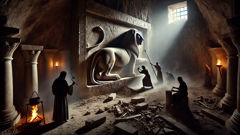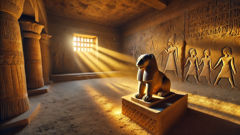Introduction
In the cradle of civilization, where the Tigris and Euphrates rivers shaped the fate of empires, lay the land of Elam—an ancient kingdom brushed by golden deserts and crowned with verdant mountains. Here, 5,000 years ago, artisans and priests conjured legends from mud and fire, shaping not only their world but also the stories that would outlast their cities. Among their creations, one figure stood apart: the Guennol Lioness. Carved from limestone, small enough to fit in a palm yet emanating an aura that dwarfed even kings, she became both relic and riddle. With a lion’s sinew and a woman’s poise, her gaze was said to pierce through time, her presence a warning and a blessing. Locals whispered that she was no mere idol; she was the keeper of ancient wisdom, the guardian of Elam’s deepest mysteries. For generations, travelers, scholars, and storytellers ventured from distant lands—Babylon, Susa, and beyond—drawn by tales of her power. Some sought her for fortune, some for knowledge, and a few, for redemption. Yet, none truly understood the origins of the Guennol Lioness or why she endured while kingdoms rose and fell around her. Her legend was woven into the very sand, carried on the wind through ruins and bustling bazaars, promising that whoever unraveled her secret would grasp the wisdom of gods. This is the story of the Guennol Lioness: how she came to be, how she watched over Elam, and how her spirit echoes even now in the heart of Mesopotamia.
The Shaping of the Guardian: Birth of the Guennol Lioness
Long before written words etched the stories of kings and conquests, in an era when the land itself was still considered young, the people of Elam turned to the earth for guidance. The priests of Susa spoke of spirits in stones, believing that wisdom resided not only in scrolls but in the living memory of clay, wood, and rock. It was during a period of unrest—when floods threatened crops and omens foretold the rise of foreign powers—that the high priestess Tashmetu received a vision under a moonless sky. In her dream, a lioness with human eyes prowled the borderlands between desert and city, her mane shimmering with starlight and her voice echoing with forgotten tongues. She beckoned Tashmetu to the foot of the Zagros mountains, where silver streams cut through the ochre soil. There, at dawn, the priestess uncovered a limestone boulder shaped like the flank of a great beast. The artisans she summoned worked in silence, their hands guided by faith more than skill. Days stretched into weeks. They carved the body with the taut muscles of a lioness—shoulders hunched in eternal vigilance—and bestowed upon her the upright posture and composed features of a woman. The Guennol Lioness emerged as a creature not quite of this world: fierce but serene, powerful yet nurturing. They believed she would become the voice between mortals and the divine, her gaze a mirror for truth and her presence a shield against chaos.

On the night of her completion, the temple was awash with incense and song. Elders, warriors, and children gathered to witness the unveiling. The high priestess declared, "Within her lies the spirit of the mountains, the wisdom of the lioness, and the heart of our people." Lightning forked across the heavens as if in answer, and a warm breeze swept through the chamber, flickering the torches and causing shadows to dance along the limestone walls. For many, it was proof that the gods themselves had entered the statue. From that day, the Guennol Lioness was enshrined in the innermost sanctum, beyond the reach of ordinary supplicants. Only those chosen by lots—often in times of dire need—could approach her directly. It was said she whispered counsel in dreams and sent warnings through the cries of animals at dusk. Stories grew of her protecting Elam from invading tribes and quelling droughts with her mysterious favor. Through wars, alliances, and shifting rulers, her image endured. Even those who doubted her divinity couldn't deny the way her presence seemed to settle disputes or inspire courage before battle.
Yet, not all were content with the Lioness’s silent guardianship. Among the priesthood, a rift emerged. Some argued that her wisdom belonged only to the initiated, while others insisted that the whole city should benefit from her protection. Rumors of secret rituals and hidden scrolls abounded. The young scribe Ninsun, drawn by curiosity and a yearning for truth, began to visit the temple after dark. She watched the patterns of moonlight across the Lioness’s face, hoping for a sign. One night, as she traced the ancient inscriptions circling the altar, she felt a warmth radiating from the statue—a heartbeat in stone. A voice as soft as sand whispered, "Seek not to possess wisdom, but to be worthy of it." Ninsun understood then that the Lioness was not a giver of easy answers but a challenger, testing the hearts of those who approached. The story of the Guennol Lioness spread beyond Elam’s borders. Travelers carried tales of a mystical guardian who asked riddles of all who sought her aid. Some returned claiming their fortunes had changed; others vanished, lost in desert storms or lured by mirages. Through these generations, her legend grew, blending fact and myth until the Lioness became a symbol of the quest for wisdom itself—a journey as perilous as it was rewarding.
The Guardian Tested: Trials of Wisdom and Power
As word of the Guennol Lioness’s powers traveled along the trade routes linking Elam to Sumer, Akkad, and distant Babylon, both reverence and envy took root. Merchants brought her image on amulets; storytellers embroidered her legend until she became not just a guardian but an oracle. Yet, it was within Elam itself that her role would be most fiercely contested. During the reign of King Ishmekarab, whose rule was both prosperous and perilous, omens foretold famine. The harvest had failed, and rain clouds hung stubbornly at the horizon’s edge. The council of elders, divided between tradition and innovation, sought counsel from the Lioness. That year, the city’s gates were opened to all, and people from every quarter of Susa poured into the temple’s courtyard, carrying petitions written on clay tablets and gifts of grain or incense. Before the Lioness, the air shimmered with hope and anxiety. The high priest performed rituals from dawn until dusk, reciting hymns in the old tongue. On the third night, as thunder rolled over the city, a voice was heard—not from a priest or supplicant, but as if rising from the heart of the statue itself. "Balance must be restored," it intoned. "Greed sows famine, and only unity reaps abundance." No one could say if it was truly a miracle or a clever ventriloquism, but the effect was immediate. The market’s grain stores were opened to the hungry, fields were replanted in collective effort, and feuds were set aside. Within weeks, green shoots pierced the earth, and rain returned to the land.

The Lioness’s legend grew stronger, but so did resentment among those who had lost their privileges. In secret, a cabal of merchants and minor nobles plotted to claim her wisdom for themselves. They believed that if they could move the statue to their own private shrine, they would control the fate of the city. Late one moonless night, cloaked figures crept into the temple, intent on their theft. As they lifted the Lioness from her altar, a chill swept through the air and their torches flickered out. The ground beneath them trembled as if the earth itself was protesting. In panic, one of the thieves dropped the statue; it landed with a soft thud but did not break. Instead, an eerie stillness fell over the temple. By dawn, the thieves had vanished without a trace—whether swallowed by the earth or spirited away, no one knew. From then on, it was said that the Lioness judged all who sought to misuse her power, rewarding only those whose hearts were pure.
The Guennol Lioness became more than an object of worship; she was woven into Elam’s laws and customs. During disputes, elders would sit before her, believing her silent presence compelled truthfulness. Warriors swore oaths on her name before going to battle. Children learned that the Lioness did not promise safety without sacrifice; she demanded honesty and courage. There was one who tested these lessons more than any other: Ninsun, now a grown woman and keeper of the temple’s chronicles. When a new wave of invaders approached from the west, bringing with them iron weapons and unfamiliar gods, fear threatened to tear Elam apart. The council debated surrender, but Ninsun knelt before the Lioness, seeking guidance. She remembered the words whispered to her in her youth—"Seek not to possess wisdom, but to be worthy of it." Rising, she addressed the people, urging unity over suspicion and faith over despair. Her courage inspired a coalition of defenders who, guided by the Lioness’s symbol, repelled the invaders and preserved the city.
Over time, Ninsun’s story merged with that of the Lioness. Some claimed she became the statue’s spirit-keeper after her death; others believed her soul was reincarnated as a great lioness that roamed the mountains at dusk. What endured was the belief that true wisdom is never hoarded but shared—that the Guennol Lioness was a living testament to the strength found in humility and the light kindled by those who dare to seek understanding.
Conclusion
The centuries rolled onward. Empires toppled and new gods claimed temples built over old ones. Yet, fragments of the Guennol Lioness’s legend survived: etched on shards of pottery, whispered in lullabies, woven into carpets traded far from Susa’s walls. Those who stumbled upon her likeness—be it in a dusty storeroom or beneath a merchant’s awning—still felt a shiver of awe. For in her gaze, both fierce and knowing, they glimpsed the spirit of a people who understood that wisdom is neither a birthright nor a secret to be stolen. It is a journey—fraught with peril, shadowed by temptation, and brightened by acts of courage and humility. The Lioness’s story endures not as a relic of superstition but as a living parable: a reminder that guardianship is not about domination but about service; that true power lies not in possessing wisdom, but in sharing it generously. Today, as the Guennol Lioness resides in the hands of those who cherish history, her legend continues to ripple outward—a timeless call to seek understanding, to unite in purpose, and to honor the mysteries that connect us all to our ancient beginnings.













